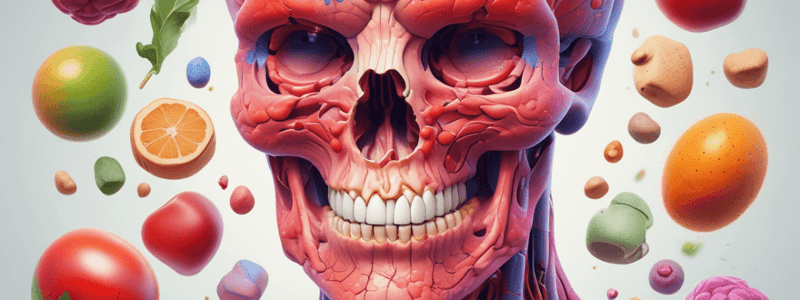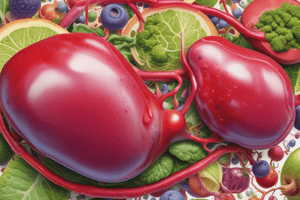Podcast
Questions and Answers
Which of the following is NOT a source of cell nutrients circulating in the blood?
Which of the following is NOT a source of cell nutrients circulating in the blood?
- Dietary intake
- Synthesis in body tissues from precursors
- Excretion from liver, kidney, and lungs (correct)
- Release from storage in body tissues
Which of the following is a physiological change that can affect the blood concentration of cell nutrients and waste products?
Which of the following is a physiological change that can affect the blood concentration of cell nutrients and waste products?
- Enzyme deficiency states
- Atherosclerosis
- Exercise (correct)
- Diabetes
In which of the following tissues do cell nutrients undergo metabolism?
In which of the following tissues do cell nutrients undergo metabolism?
- All tissues except mature erythrocytes (correct)
- Liver only
- Kidney cortex only
- Adipose tissue and skeletal muscle only
What is the primary function of cell nutrients in body tissues?
What is the primary function of cell nutrients in body tissues?
Which of the following is a pathological change that can affect the blood concentration of cell nutrients and waste products?
Which of the following is a pathological change that can affect the blood concentration of cell nutrients and waste products?
Which of the following is NOT a metabolic process that cell nutrients undergo in body tissues?
Which of the following is NOT a metabolic process that cell nutrients undergo in body tissues?
What is the primary role of ATP and ADP in the cell?
What is the primary role of ATP and ADP in the cell?
What is the relationship between ATP and ADP in terms of their chemical structure?
What is the relationship between ATP and ADP in terms of their chemical structure?
What happens to the energy released during the catabolism of fuel molecules?
What happens to the energy released during the catabolism of fuel molecules?
What is the significance of the high-energy phosphate bond in ATP?
What is the significance of the high-energy phosphate bond in ATP?
Why is ATP considered a carrier of free energy rather than a store?
Why is ATP considered a carrier of free energy rather than a store?
What are the high-energy and low-energy signals in the cell?
What are the high-energy and low-energy signals in the cell?
What is the role of creatine phosphate in muscle cells?
What is the role of creatine phosphate in muscle cells?
What is the relationship between creatinine and skeletal muscle mass?
What is the relationship between creatinine and skeletal muscle mass?
What is the significance of measuring creatinine levels in blood and urine?
What is the significance of measuring creatinine levels in blood and urine?
What is the difference in creatinine excretion between males and females?
What is the difference in creatinine excretion between males and females?
What is the main function of cell metabolism?
What is the main function of cell metabolism?
Which type of pathway involves the breakdown of larger molecules into smaller ones?
Which type of pathway involves the breakdown of larger molecules into smaller ones?
What is the function of NADPH in cell metabolism?
What is the function of NADPH in cell metabolism?
Which vitamin is nicotinamide derived from?
Which vitamin is nicotinamide derived from?
What does oxidation involve in biological reactions?
What does oxidation involve in biological reactions?
Study Notes
Cell Nutrients in Blood
- Nutrients in the blood include glucose, amino acids, and fatty acids, while oxygen is essential for metabolism.
- Hormonal changes or physiological factors like exercise can influence blood nutrient concentration.
Tissue Metabolism
- Metabolism of nutrients predominantly occurs in liver, muscle, and adipose tissues.
- These tissues convert nutrients into energy or building blocks for cellular functions.
Primary Functions of Nutrients
- Cell nutrients primarily serve as energy sources and building blocks for cellular structures.
- They play critical roles in growth, repair, and maintaining cellular functions.
Changes Affecting Nutrient Concentration
- Pathological changes, such as diabetes or kidney disease, can disrupt the balance of nutrient levels and waste products in the blood.
- Physiological changes may include fasting, exercise, or hormonal fluctuations affecting nutrient delivery and metabolism.
Metabolic Processes
- Common metabolic processes include glycolysis, Krebs cycle, and oxidative phosphorylation.
- Nutrients do not undergo breakdown through enzymatic hydrolysis as a metabolic process.
ATP and ADP Role
- ATP (adenosine triphosphate) and ADP (adenosine diphosphate) are crucial for energy transfer within cells.
- ATP contains three phosphate groups, while ADP has two, with energy stored in the high-energy phosphate bonds.
Energy Release in Catabolism
- Energy released during the breakdown of fuel molecules is captured in ATP for cellular work.
- This energy fuels various processes, including muscle contraction and biosynthesis.
Significance of ATP
- The high-energy phosphate bond in ATP is vital for energy transfer during chemical reactions.
- ATP is termed a carrier of free energy because it readily donates energy for biological reactions, rather than merely storing it.
Intracellular Signals
- High-energy signals, represented by ATP, indicate energy abundance, while low-energy signals, such as ADP or AMP, suggest energy depletion.
Creatine Phosphate in Muscle
- Creatine phosphate serves as a rapid energy reserve in muscles, quickly regenerating ATP during intense activity.
- The amount of creatine in muscles correlates with skeletal muscle mass, aiding in energy provision for muscle contractions.
Creatinine and Muscle Mass
- Creatinine is a waste product of creatine metabolism; its levels indicate kidney function and muscle mass.
- High levels of creatinine in blood and urine signify impaired kidney function or increased muscle breakdown.
Gender Differences in Creatinine Excretion
- Males typically have higher creatinine excretion than females due to greater muscle mass and size differences.
Functions of Cell Metabolism
- The main function of cell metabolism is to convert nutrients into usable energy and maintain homeostasis.
- Catabolic pathways break down larger molecules into smaller, energy-releasing products.
Role of NADPH
- NADPH (nicotinamide adenine dinucleotide phosphate) is critical for anabolic reactions and acts as a reducing agent in biosynthesis.
- Nicotinamide, a precursor to NADPH, is derived from niacin (vitamin B3).
Oxidation in Biological Reactions
- Oxidation involves the loss of electrons or hydrogen atoms from molecules, resulting in energy release essential for metabolic pathways.
Studying That Suits You
Use AI to generate personalized quizzes and flashcards to suit your learning preferences.
Description
Test your knowledge on cell metabolism, blood nutrients, and waste products. Learn about the importance of maintaining normal cellular function and how clinicians measure substances in blood for diagnosis and treatment monitoring.




